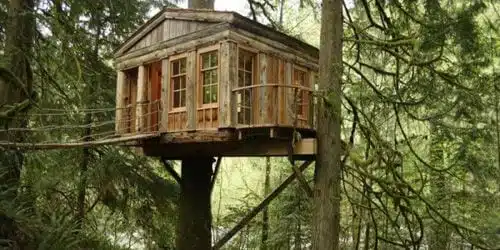
Pete Nelson makes his living building impressive, complex treehouses. He and his family live in Fall City, Washington, where they maintain a treehouse-themed bed and breakfast called TreeHouse Point. It sounds like something of a treehpuse aficionado’s fantasy, but once Pete gets to talking, so full of bravado and enthusiasm, Treehouse Masters shows itself to be another kind of fantasy, the kind we’ve come to expect of reality TV.
This fantasy features workers who’ve found a way to turn their dreams into a livelihood. Treehouse Masters introduces it with a credits sequence that effectively zeroes in on the childlike appeal of treehouses, cutting from grainy footage of a single small platform in the trees to a series of the monumental structures Pete builds, a sequence spelling out a perfect union of youthful daydreams and American entrepreneurship.
Each episode of Treehouse Masters, premiering 31 May on Animal Planet, follows Pete and his crew as they tackle a new commission. It’s an appealing enough premise, mixing light entertainment and how-to gusto. The customers featured in the first episode are a couple in Texas, Jimmy and Sandy, with land that’s been in their ownership for over 100 years. The cameras highlight a few predictable Southern details (cows! ranch houses! cowboy hats!), before moving on to portray an encounter a big ole’ Southern family and between their Pacific Northwestern employees that’s so mild you could be forgiven for forgetting about all the hubbub regarding red and blue states.
The visit to Texas demonstrates Pete’s mode, his easygoing approach to his work, no matter the environment. Combining a rough-hewn, DIY fortitude with a camera-ready smile, Nelson consults with Jimmy and Sandy to plan their treehouse, which seems less like a treehouse and more like a single-story house that’s set a little higher in the air than usual. Pete surveys the surroundings (“The best way to judge a location is to see it from the tree’s point of view”), finds the ideal site, then calls in his merry band to put the whole thing together.
Pretty much everyone on Nelson’s crew is laid-back and attractive, and any momentary hitches they encounter in the process come across more as decisions made in postproduction than any genuine adversity. When Jimmy and Sandy advance the schedule for completing the construction without warning, it takes Nelson all of 90 seconds of air time to devise a solution. The plot here rehearses the conventions of reality programming — expectation, obstacle, resolution — more than it does the specifics of treehouse construction.
With this treehouse underway, Pete takes a brief sojourn to repair another one, in the wonderfully named Uncertain, Texas. Here he finds an old fishing shanty in the bayou, and the client, Lonnie, pitches in on the repairs, along with his fishermen friends. As they share a couple of colorful anecdotes, the show offers a convincing depiction of Texas as one big, happy family, where are any potential differences of opinion are obliterated by a mutual enthusiasm for treehouses.
This family doesn’t go in for revelatory details, but Pete walks us through basics, say, what kind of wood to use or how to secure the various parts of the structure. Jimmy and Sandy’s treehouse seems fairly ordinary except for its size, and they decide against the more outlandish attributes – trapdoors, bridges – briefly exhibited by the more flamboyant structures displayed in the opening sequence.
Inside, though, it’s hardly rustic, but rather, outfitted with flat-screen TV and a full bathroom and kitchen. This makes everybody happy again, the show wrapped up with a neat, triumphal montage that’s both moving and artificial. Then Nelson’s crew returns to their home nest to await their next assignment, as they live out a dream that’s perfectly watchable, cheerfully inoffensive, and unlikely to inspire much passion or ire from anyone.
